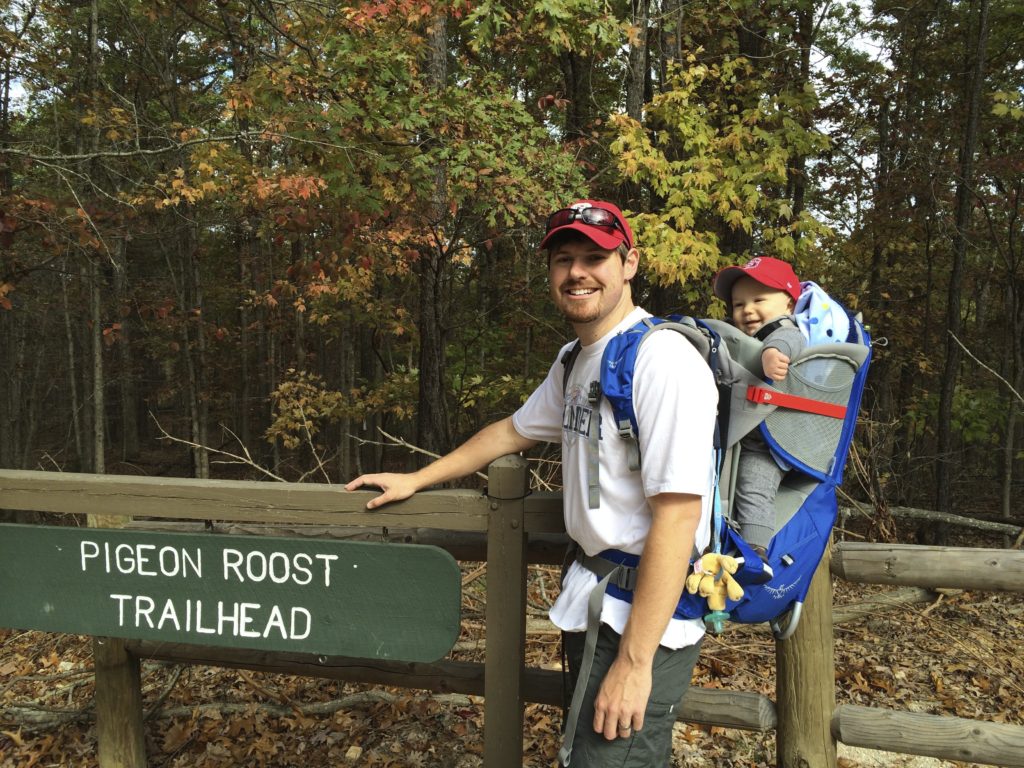How to Wear a Baby Carrier Backpack
Thekidpacker.com may receive a small commission for purchases made through links in this post.
How to wear a baby carrier backpack?
Updated: October 28, 2021
A guide to wearing a baby carrier backpack
We have talked a lot about the features of baby carrier backpacks and what you can do with them but, we haven’t discussed the basics of how to wear a baby carrier backpack. So, here is our guide to properly wearing a baby carrier backpack!
- Torso length adjustment
- Hip belt
- Shoulder straps/load lifters
- Cockpit compression
The Goal
So, now that you have purchased your baby carrier backpack, how do you wear it? Your ultimate goal is to comfortably carry your little travel partner for extended periods of time.
In order to accomplish this goal you need a properly fit and adjusted baby backpack carrier. In general, you want to utilize skeletal support versus muscular support. What exactly does that mean? You want to use the strength of your frame and not exert your muscles as much as possible. You also want to utilize the fit adjustments to centralize and pull the weight of the baby carrier backpack as close to you as possible.
Once you have the torso adjusted to your frame size and fit the hip belt such that your hips do the heavy lifting you are well on your way to a properly fit baby carrier backpack. You can then tweak all of the smaller adjustments to fully customize the fit of your baby carrier backpack.
So, let’s take a look at how to accomplish our goal and how to wear a baby carrier backpack!
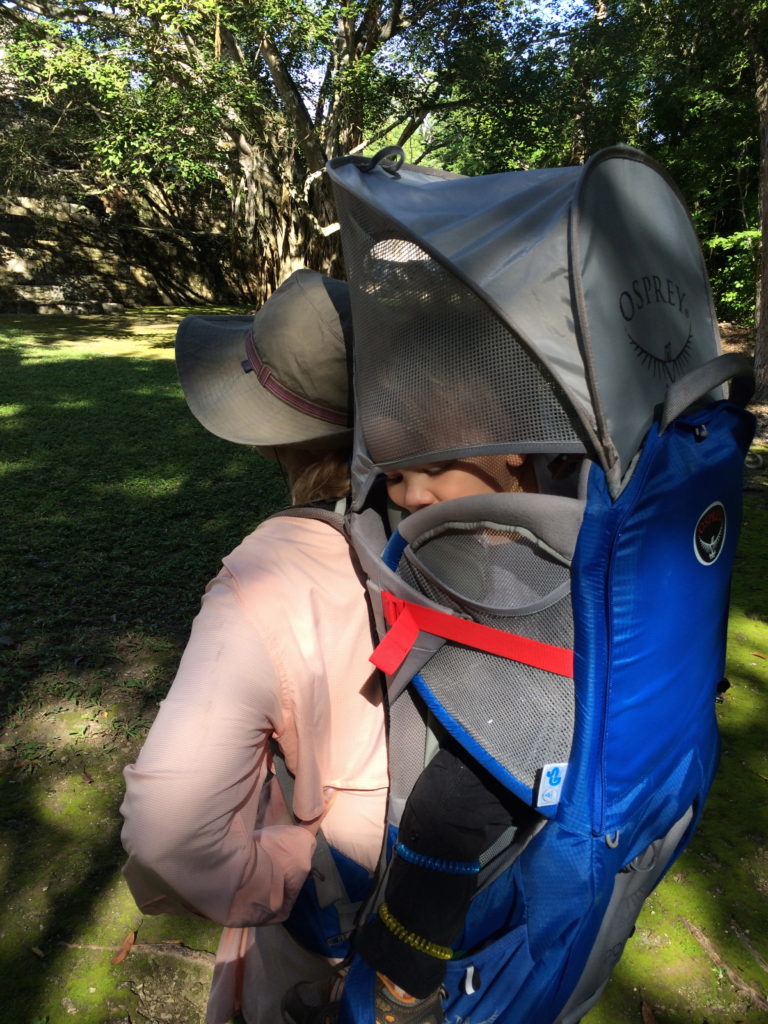
1. Torso Length Adjustment
In order for most baby carrier backpacks to fit most frame sizes, they include torso adjustment features. Some of these features are robust and some simple, but most baby backpack carriers on the market fit a wide range of adult sizes. We will use our top rated baby backpack carrier the Osprey Poco Plus as an example of how the torso adjustments typically work.
In the image below you see a tensioned back panel with an access hole for the torso adjustment mechanism. On the Osprey Poco Plus, you lift the plastic piece which then releases the entire shoulder strap assembly. This particular baby backpack carrier can be adjusted from a 15-22″ torso length. In order to choose the torso length for you, we recommend selecting a size and trying it out. Once you find the fit that suits you best, lock it in place by pushing the plastic piece down flat. There are sizes listed on the inside of the back panel as a reference.
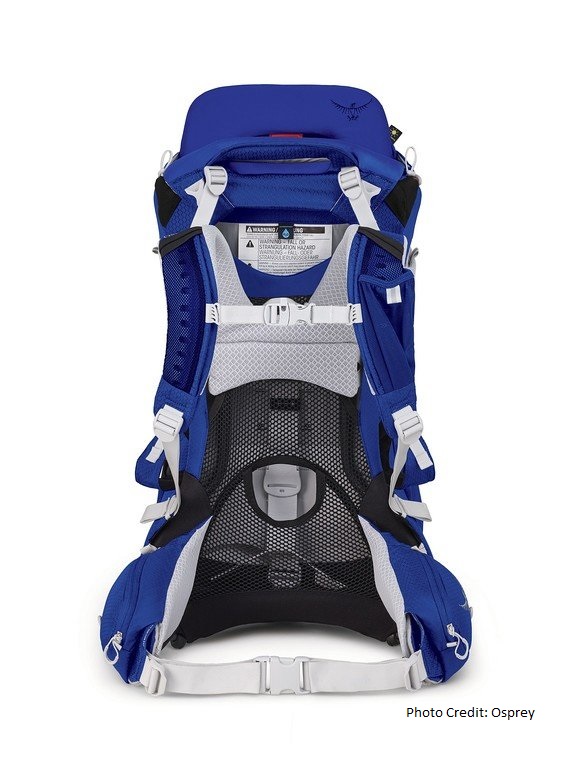
When choosing your perfect torso length pay attention to where the hip belt falls. The hip belt should rest just above your hip bones. Also, take note of how tight the shoulder straps feel on your shoulders. You should be able to comfortably slide your finger between your shoulder and the shoulder strap.
When switching between users, its as easy as moving the torso adjustment to their size then once they have the pack on, they can fine tune the other straps as needed.
2. Hip Belt
At first you may think the hip belt less important than the shoulder straps. While both are necessary, the hip belt should be doing most of the heavy lifting. It is much less fatiguing for the wearer to have the weight dispersed to the hips/legs as opposed to weight hanging on your shoulders. The hip belt should rest just above your hip bones. This may feel unnaturally high, but is best for overall comfort and stability.
Once you buckle the hip belt, pull both straps evenly towards each other until the hip belt feels snug. Make sure the padded sections of the hip belt rest on your hip pressure points and that the buckle is centered. Some baby carrier backpacks (Thule Sapling Elite and Osprey Poco Plus for example) have extendable hip belts which extend the padded section to comfortably fit larger waists.
You will likely adjust the hip belt as you wear the baby carrier backpack until you find your preferred tightness. We typically prefer the hip belt on the tighter side so that we can comfortably have looser shoulder straps.
If you have a smaller frame, you will likely have excess straps once you have tightened the hip belt. These straps can be tied/tucked away.
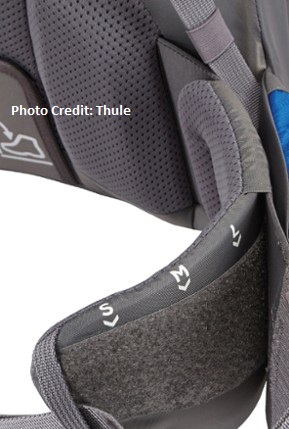
3. Shoulder Straps/Load Lifters
Now that the heavy lifting is done via the hip belt, we can start fine tuning the baby carrier backpack fit. The shoulder straps on most all baby backpack carriers work the same as any other type of backpack. To tighten the shoulder straps pull down on the straps that should fall just above your hips. You want to tighten them to the point where you can still fit your fingers between the strap and your shoulder.
After you tighten the shoulder straps, find the load lifters located just above where the shoulder strap attaches to the pack. When you tighten the load lifters pull the straps out then down towards your body. Load lifters pull the baby carrier backpack towards you which helps center the weight over your hips. Tightening the load lifters is a critical step to happy shoulders!
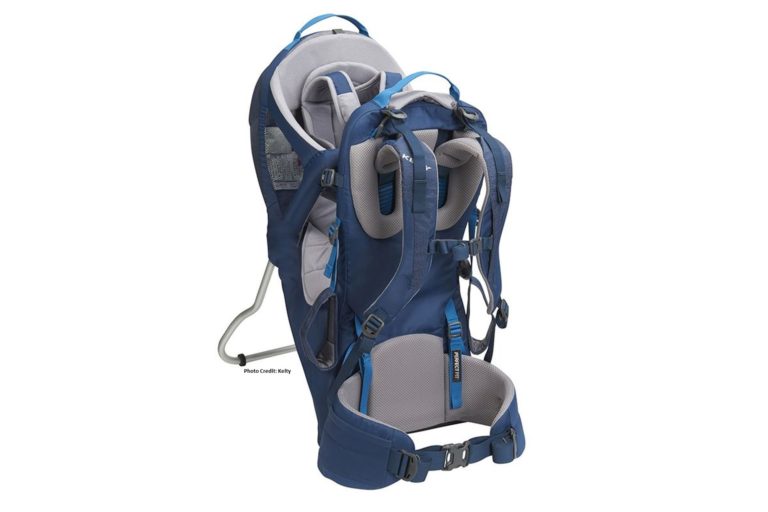
4. Child Cockpit Compression
Not all baby carrier backpacks include child cockpit compression and instead have a more rigid frame. Thule does a particularly good job of providing cockpit compression and makes it easy while wearing the pack. Child cockpit compression is an important feature in our opinion and we wish it was provided standard on all child carrier backpacks. Keeping the cockpit somewhat compressed moves the weight of the pack closer to the wearer’s body which provides a more stable and comfortable experience.
If your baby carrier backpack includes child cockpit compression, you want to compress the pack just enough that you can feel the weight shift towards you while allowing your child the space they need. From our experience, having the child cockpit compressed prevents your passenger from wiggling around too much. This is helpful for both the wearer and the child in that the wearer feels more stable and the child can better nap with less movement.
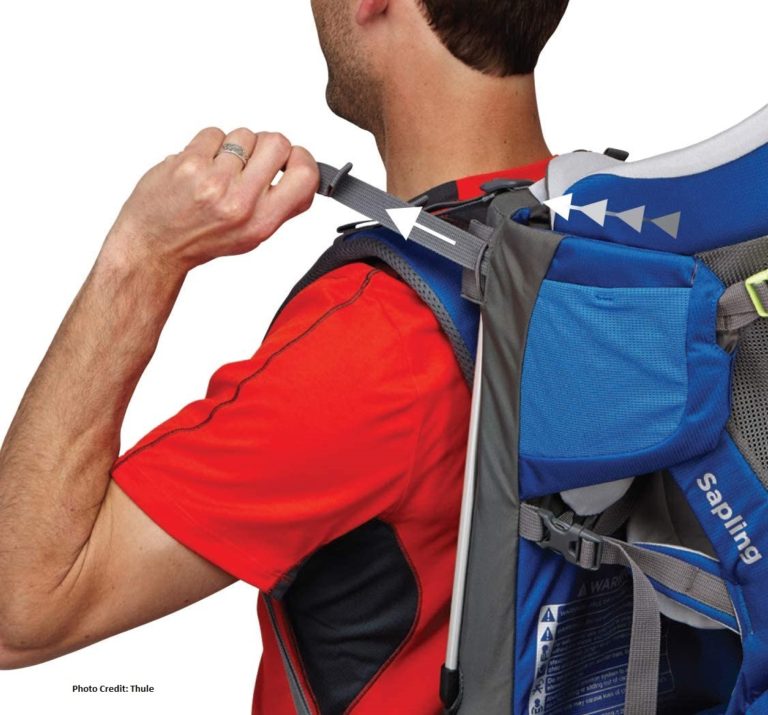
How to Wear a Baby Carrier Backpack - Tips
Now that you have your baby carrier backpack fully adjusted, how do you put it on and take it off? Sounds simple enough but, even the best designed child carrier backpacks can be awkward to put on and take off.
How to Put on Your Baby Carrier Backpack
To pick up and put on your child carrier with a partner, have them grab the back grab handle. Most all baby carrier backpacks have a sturdy top center handle on the back of the pack. While your partner grabs the back, you grab the front center handle, lift, then put your arms through the shoulder straps.
If you do not have a partner with you, lift the baby carrier backpack with the front top center handle then rest the carrier on your upper leg while you put your arms through the shoulder straps.
Once you have your baby backpack carrier securely adjusted on your back, pop the back kickstand in and you are ready to adventure!
How to Remove Your Baby Carrier Backpack
To remove the pack you do the same steps in reverse. First, make sure the kickstand is firmly clicked in the outward position.
If you are alone, remove one arm from the shoulder strap then transition the pack to rest on your upper thigh before using the grab handles to place on the ground.
While with a partner, they can grab the back handle while you remove the shoulder straps then grab the front handle to lower the pack to the ground.
Do make sure the ground is level before removing your grip!
How to Wear a Baby Carrier Backpack - Summary
Child carrier backpacks may look heavy and uncomfortable but, if fit properly, can be exceptionally comfortable. Remember your goal is to comfortably carry your travel partner for extended periods of time.
To recap: adjust the torso length so that the hip belt rests just above your hip bones, tighten the hip belt comfortably but secure, tighten shoulder straps such that there is a slight gap between your shoulder and the strap, tighten the load lifters, clip the chest strap 1-2″ below your collarbone.
Follow this guide for how to wear a baby carrier backpack for family adventure success!
If you haven’t decided which baby carrier back would best for your family, take a look at our Top 5 Baby Backpack Carriers:
About The Kid Packer

Here at The Kid Packer, we want to help you live your best life. A great baby backpack child carrier can help you do just that. After having used a child carrier backpack for over 1,500 miles of adventuring and exploring, we have a passion for them and know what makes a great pack that both you and your child will love. We hope our comprehensive research allows you to confidently find the right backpack for your needs!
